There are innumerous scholar studies on war propaganda WW1 posters.
The artistic and message-conveying pieces have been examined from many different perspectives, among which history, propaganda, war studies, and of course – visual arts.
Yet, how well can a textual representation depict what an artist had in mind?
If you asked us, WW1 posters have not been given the attention they deserve, and have not been properly described.
Examples of WW1 posters
Here are some excellent WW1 posters examples, and a detailed explanation of their meaning:
Recruiting men to join the army
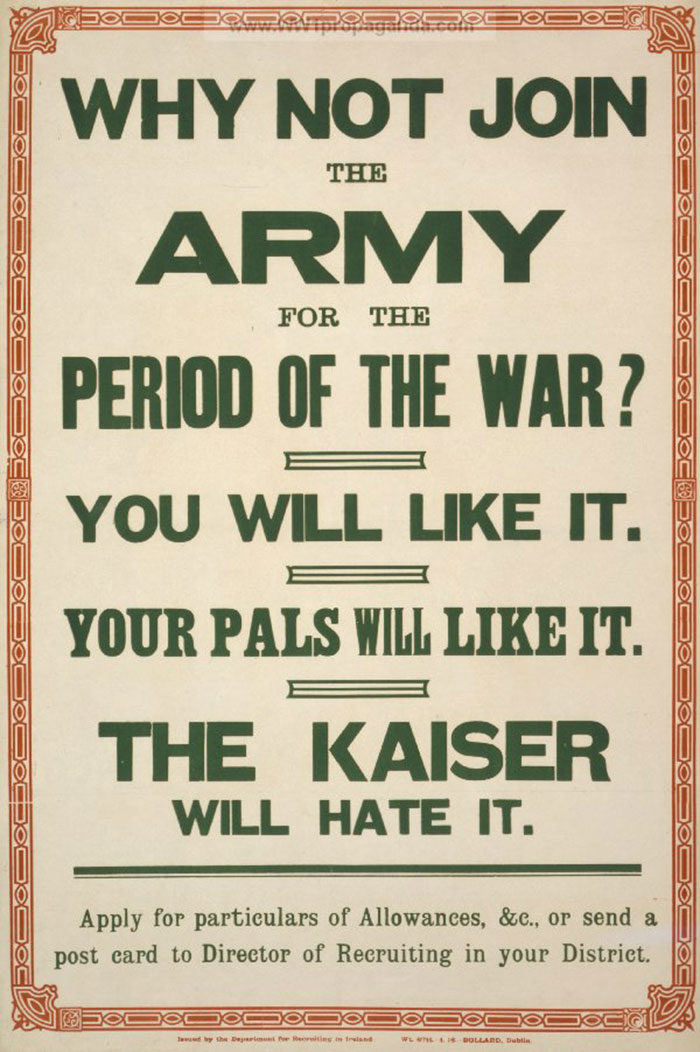
Conscription was not present in the UK before 1916, which is why posters mainly referred to men, and their sense of honor and dignity. The role of women in this process was to encourage men to join the state forces, and even pressure them to assume their patriotic duty of defending their country and their king.
What is interesting about these posters is how they interlinked military themes and family values, pointing out how men who stand for their families can stand for the country too.
The designers of these posters used art to ‘sell’ war as a better way of life – one couldn’t see the horrors of war anywhere on them, as they were all about self-motivation, enthusiasm, and pride.
Recruiting women to work
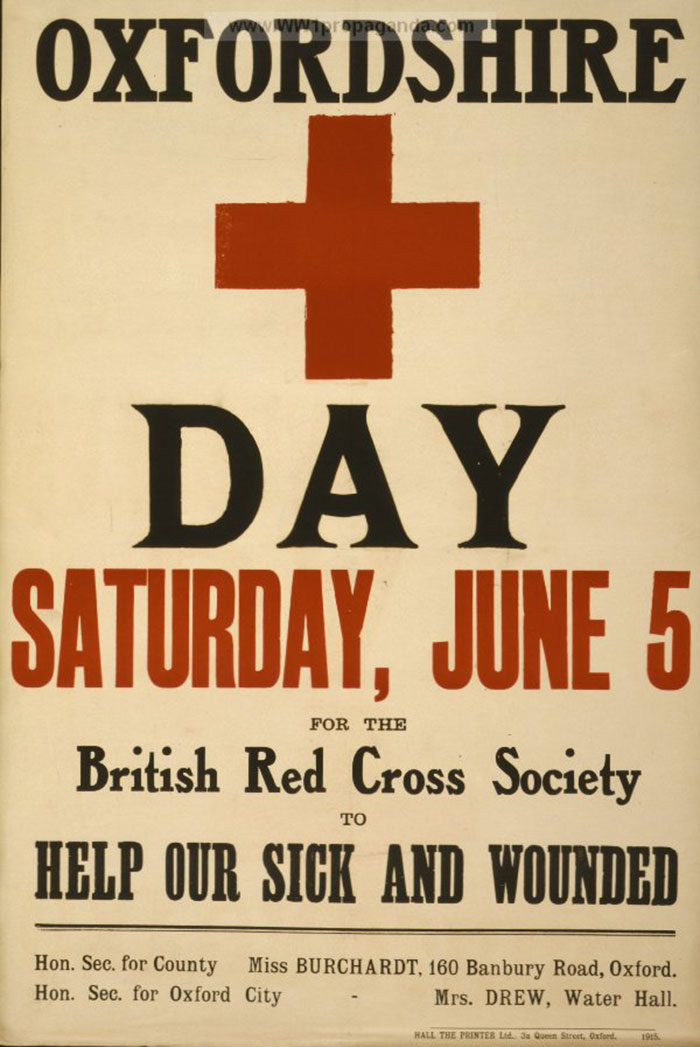
Women were not supposed to join the army, but the propaganda didn’t leave them aside. They were invited to become part of the so-called Women’s Land Army, namely to work on the production of munitions and charities for the men fighting.
One could go as far as describing these posters as encouraging, as women got to deviate from their traditional housekeeping roles to make an actual contribution. We could argue on the appropriateness of such contribution, but we can neglect the role of these posters into inspiring women to pursue more.
Persuasion strategies
WW1 posters depict many of the persuasion strategies typical for that time being. We will discuss the best among them:
The dialogue effect
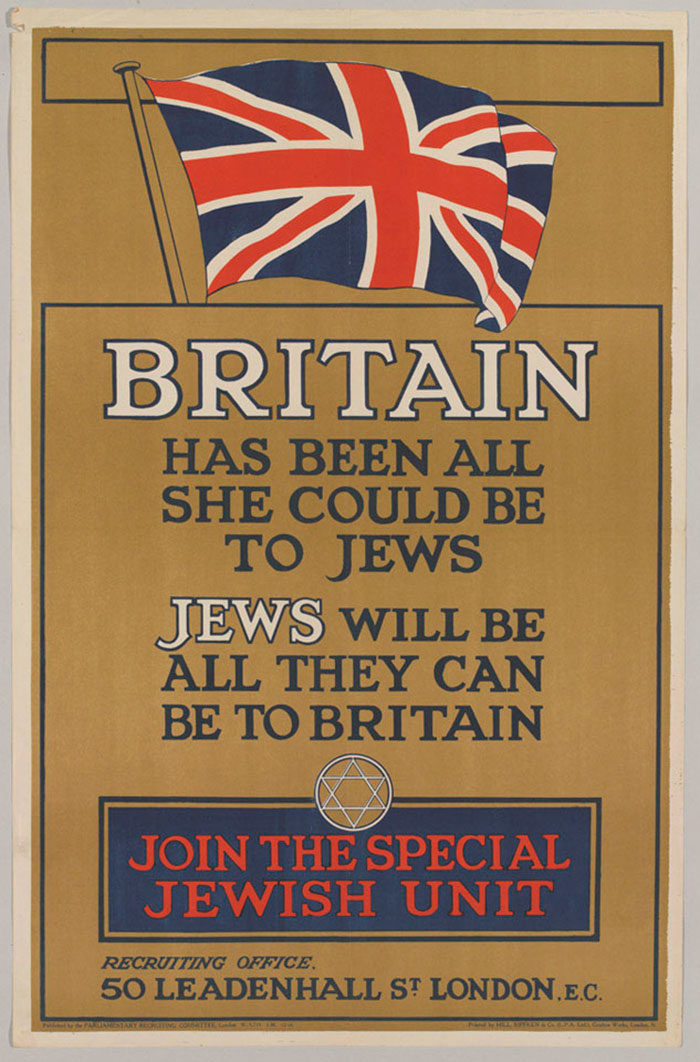
Dialogism is another great achievement of poster artists during WW1. It all started by addressing specific society groups (sportsmen, ethnicities, etc.) and introducing quotations (“Every player who represented England in rugby international matches last year has joined the colours” – as written in the Times), but soon became a trend for referring to any interested parties.
These posters will be remembered by the excess use of pronouns (both personal and possessive) and imperatives instructing people to do something or to join a community.
WW1 posters did an amazing work making viewers think, even when used for goals that were not exactly justifiable at the time. Their intention was to trigger an emotional response, which was achieved with informality. In fact, the posters managed to place great achievements a bit closer to people who never thought they’d had them, and that’s what made them so popular.
A quite common target was the image of a single men. The propaganda was not into motivating them to pursue happiness, but rather calming family men that they’d be the last to get call on the front.
Another commonly used topic was the one of Britain’s war enemies. They were offended and even demonized in a variety of ways (German Barbarians, for instance), just to make the point that they were perhaps scarier, but that God was on Britain’s side.
To provoke some action, poster artists depicted some of the worst German atrocities and invited people to hate the enemy, remembering to involve religion at all times.
WW1 Posters on Temporality and Locality
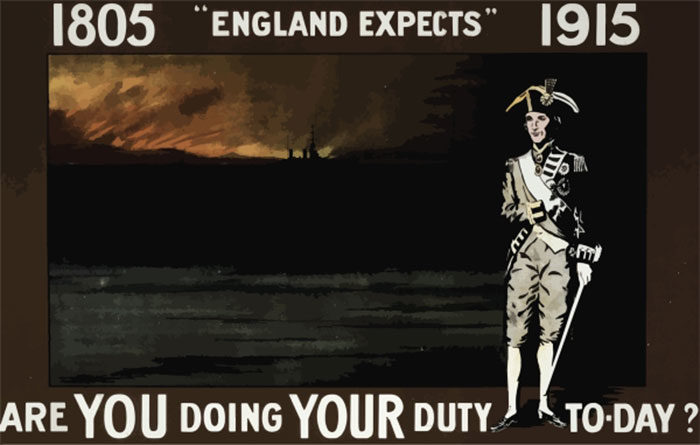
Let’s not forget that World War Posters were mainly propaganda and persuasion posters – instead of a piece you’d like and take home, they intended to wake up some fury and activate people at that very moment. To do so, they used lots of temporal markers (immediately, now, at once, today), as well as remarkable history moments and motivating quotations.
Some of them also referred to the future, but only as far as necessary to showcase the consequences of not taking action. Geographic locations were also a part of the story (Saving Britain, keeping Europe peaceful), aiming to remind people what they were fighting for.
Emotional appeal
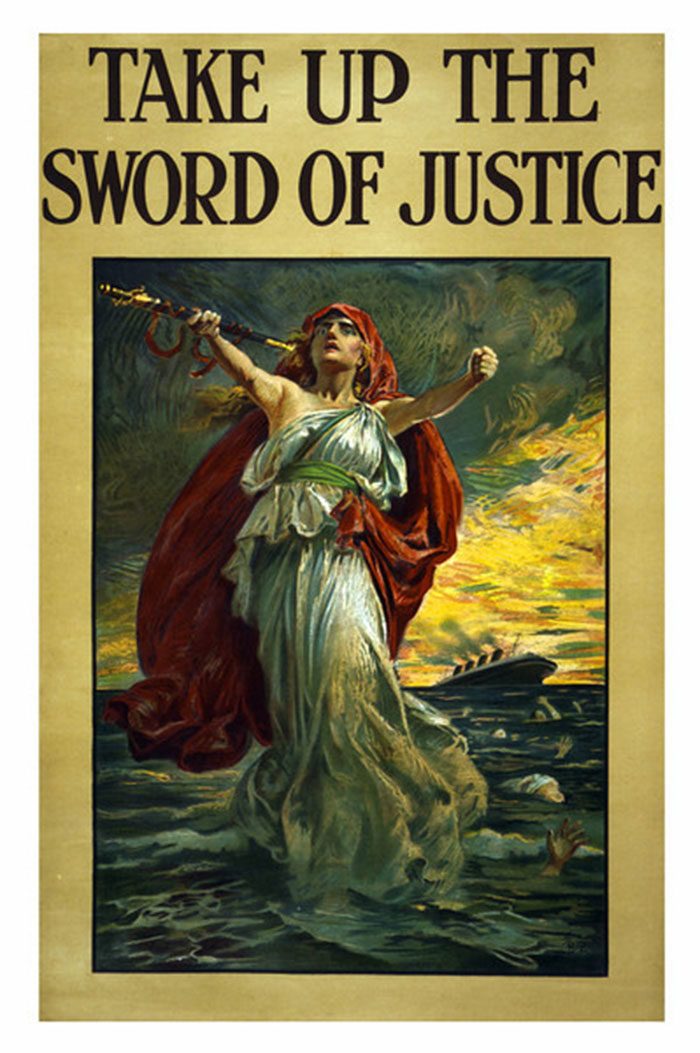
These vivid World War 1 posters were loaded with emotional incentives. Some of them conveyed positive messages of happiness and courage, but many also treated guilt, disappointment, and fear. To achieve such effects, artists overused comparative and superlative adjectives (‘way better’, ‘worst scenario’), and inverted the word order (together we are stronger).
Their goal was to urge action and to channel emotions in the desired direction. Among their tools were also war-related allusions (sinking, breaking down, falling apart), metaphors (hand of justice), and imperative addresses (People of Britain!).
National Symbolism
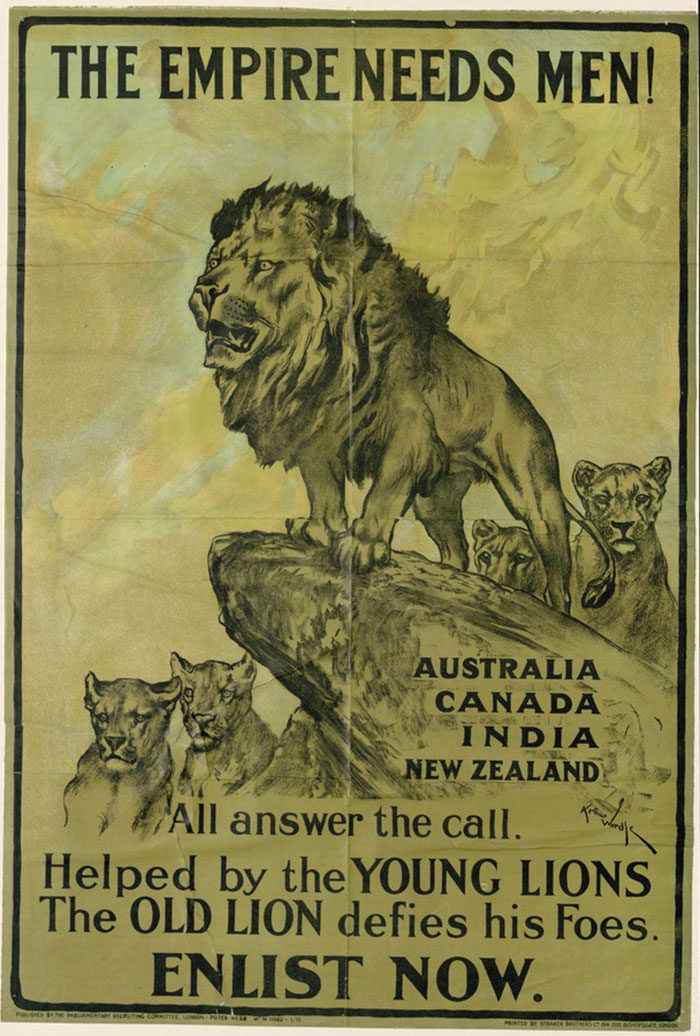
Nationalism was the core of WW1 posters, and artists employed powerful symbolism to perfect them. There was an abundance of personification and allegory, as in the case of John Bull representing Britain and Tommy Atkins in the role of the ideal British soldier.
Symbolism was used on WW1 recruitment posters to reinforce nationhood – Britain was presented as a lion, while the Empire nations were its young lions. England was often symbolized with St. George fighting the dragon.
Funds and war bonds
Countries like Germany, France, and Austria which were bounded to conscription didn’t put recruitment in the first plan. Instead, they intended to raise financing for the war.
The people who couldn’t afford to pay such contributions were asked to subscribe to war loans or to purchase bonds instead. Such scenarios were illustrated on many financial posters, the most popular of which displays coins becoming bullets and serving as shields.
Nutrition issues
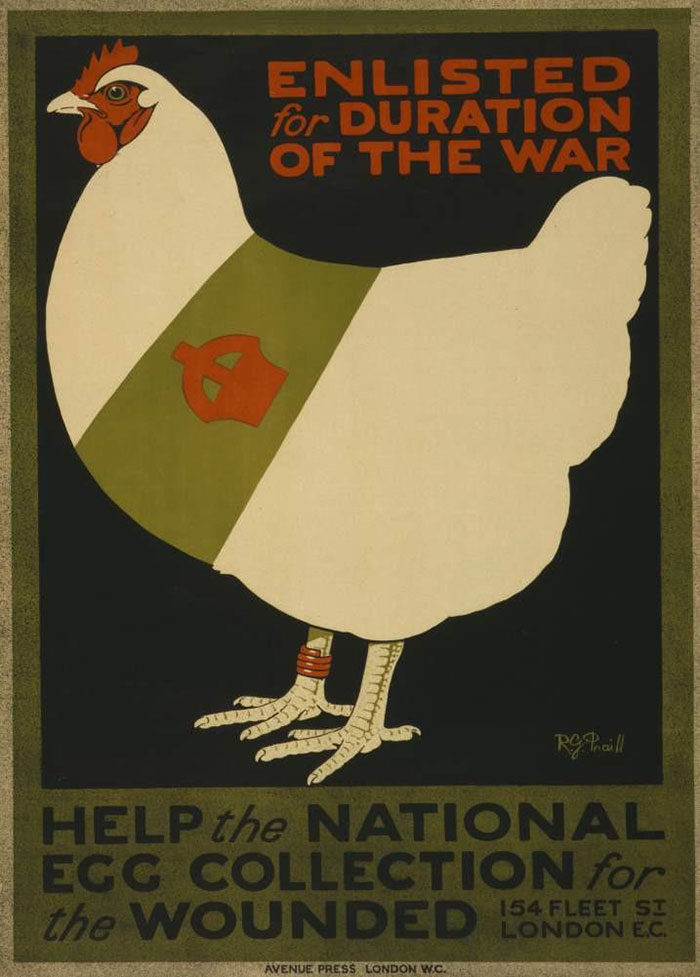
War caused hunger all over Europe, and people hoped to receive help from the United States. On the other end, relief organizations were preparing and shipping food, a process which required them to consider conservation as a new eating habit.
Poster art didn’t neglect this situation. Meanwhile, American people were asked to avoid meat, and eat more corn, fish, fruits, and vegetables. The Brits collected eggs to help wounded soldiers recover, while France organized a children competition for the best conservation poster.
WW1 Posters in different countries
Each country has a unique and recognizable poster creating culture, especially when it comes to military recruitment, propaganda, and national awareness. We’ve collected the best examples:
England
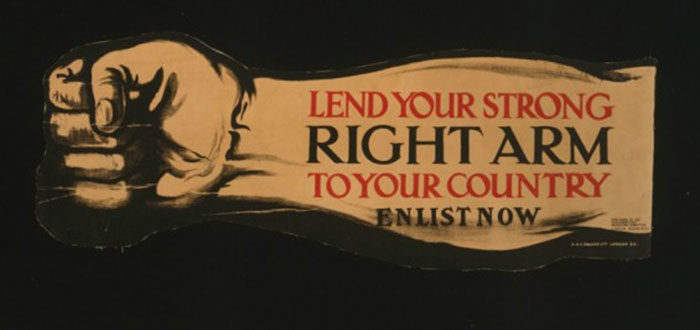
Here’s a poster supposed to embarrass those who refuse to fight.
It is shaped like an arm, which was a unique idea considering the message it had to convey.
If you ask D&D fans, this poster would work even today, but at the time it was only supposed to highlight St. George fighting the dragon.
Ireland & Scotland
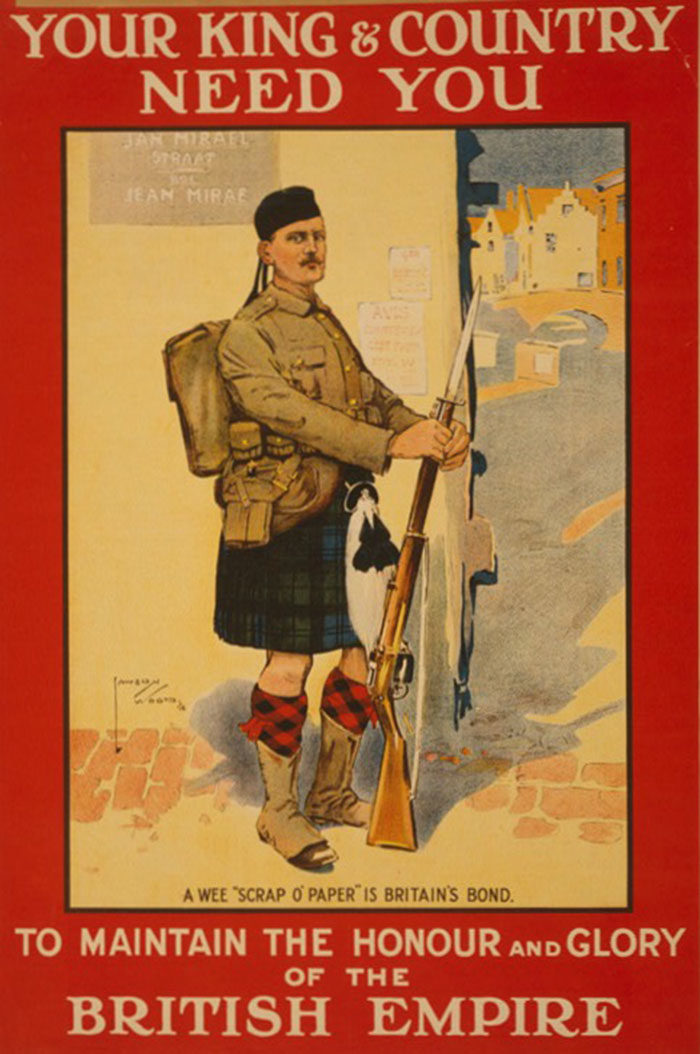
United Kingdom is a country of diverse cultures, and poster art is a good way to show it. There are pieces directed exclusively towards Scotland and Ireland, such as this subtle piece created by Lawson Wood. Here, you can see a soldier from the Scottish military, and you can read some of the region’s typical slang on the caption.
The political turmoil with the Irish was even worse, which made it quite difficult to recruit. In fact, the Irish Independence War broke out as soon as the major fights of the World War were over.
Poster artists were challenged – addressing people to join the army and defend the king was not as easy as in Scotland. To achieve a similar effect, they used Germany’s attack on their passenger ship, imposing the duty of immediate revenge.
Australia
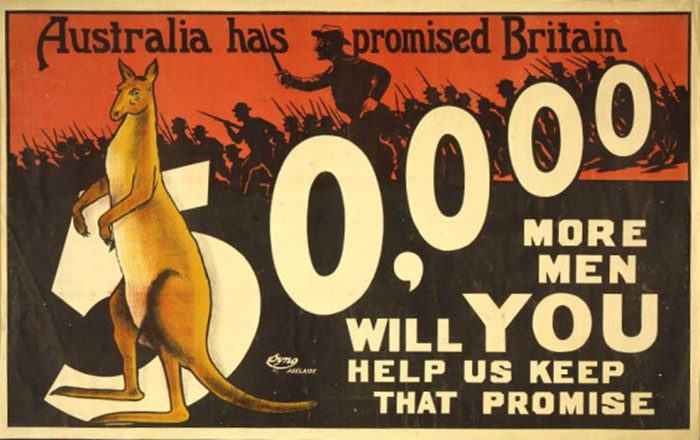
Australia’s posters during WW1 were much simpler, given that the country didn’t participate in the war. They didn’t have to recruit troops or strike up national pride – they’d only ask people to help England (if they can).
Canada
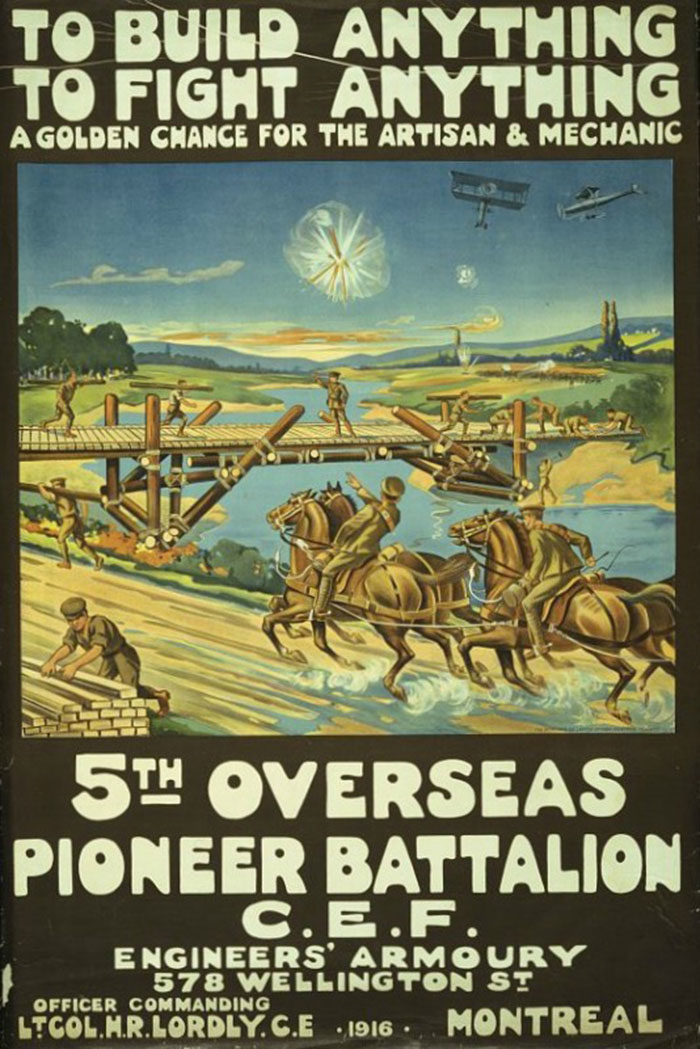
Canada created what is perhaps the most effective method of recruiting soldiers into war. It didn’t threaten them or embarrass them – instead, it showed them that it won’t last forever.
Canadian posters made promises for a better future. Their main message was that better times are about to come, and that everyone will have a better job and better conditions to live after the war.
Germany
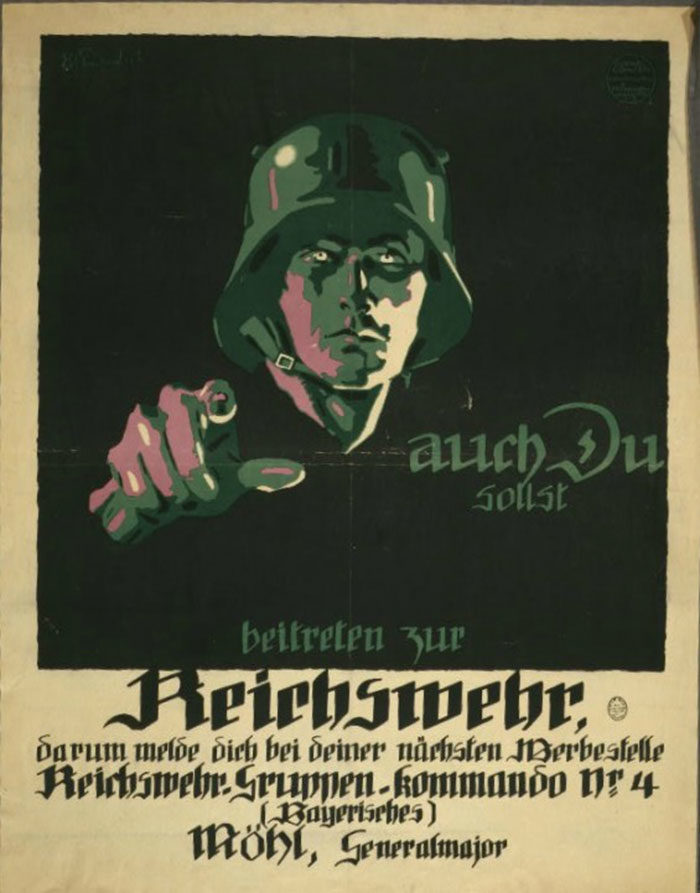
Let’s check the WW1 posters from the other side of the front. The easiest way to describe them is dark, ghostly, and slightly creepy. We don’t really understand German, but it is not difficult to guess that the message is not charming either. We’ve selected a very good piece from Julius Ussy Engelhard to explain what we mean.
Another poster that deserves attention is this Lucien Zabel work. It may lack the horrifying effect of the first example, but it would hardly motivate me to enlist for war.
U.S.A.
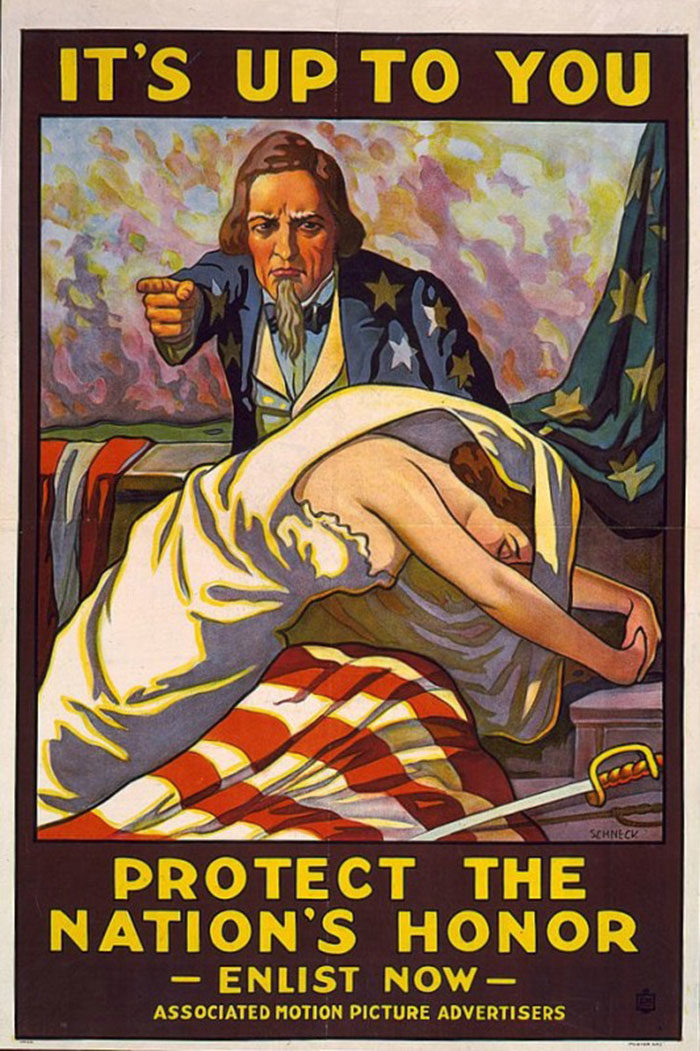
Recruitment posters in America usually referred to people enrolling in workforce, but they do have some memorable war designs. A memorable piece is the one of Uncle Sam protecting the endangered Lady Liberty, and inviting viewers to protect the honor of their nation.
The Navy
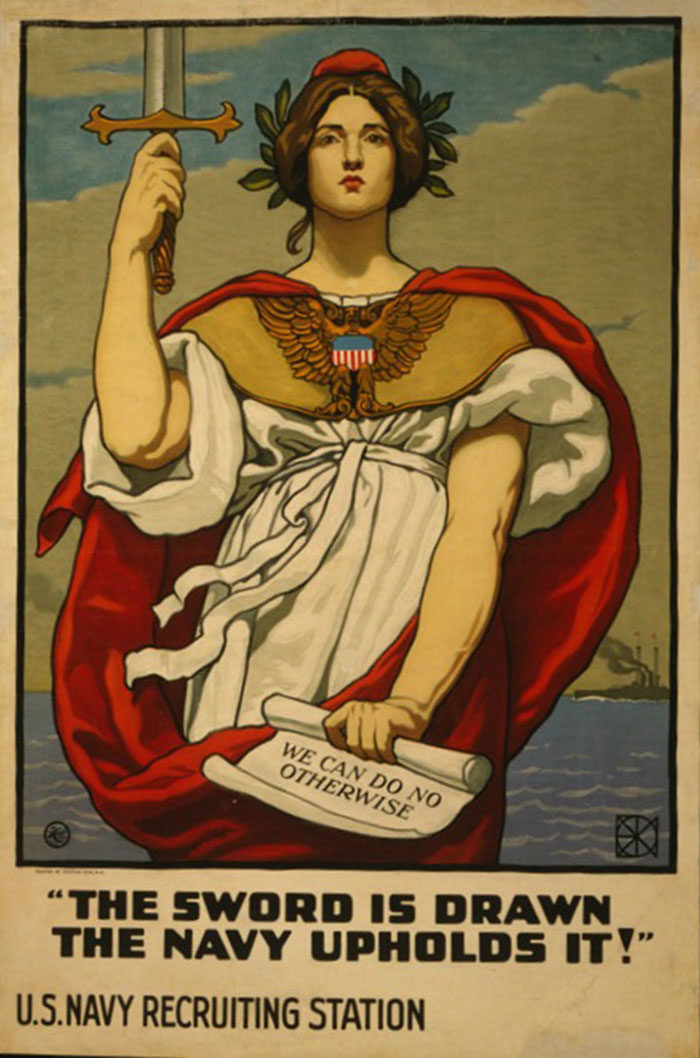
Lady Liberty appeared on many U.S. posters, and was given many different contexts. In the previous case, it was weak and fragile, but Kenyon Cox presented it as a powerful American woman with a sword in her hand. Which poster would be more inspiring for you?
Navy recruitment in the U.S was specific in many different aspects. Can you tell how doctor Strangelove used Richard Fayerweather’s Babcock image for their climax?
Here’s another great poster, this time by James Henry Daugherty. The work was released once the war was finished, but it is so good that we just can’t leave it out of our list. The message is somehow standard, and inspires people to join the Navy in order to see the world.
The Marines
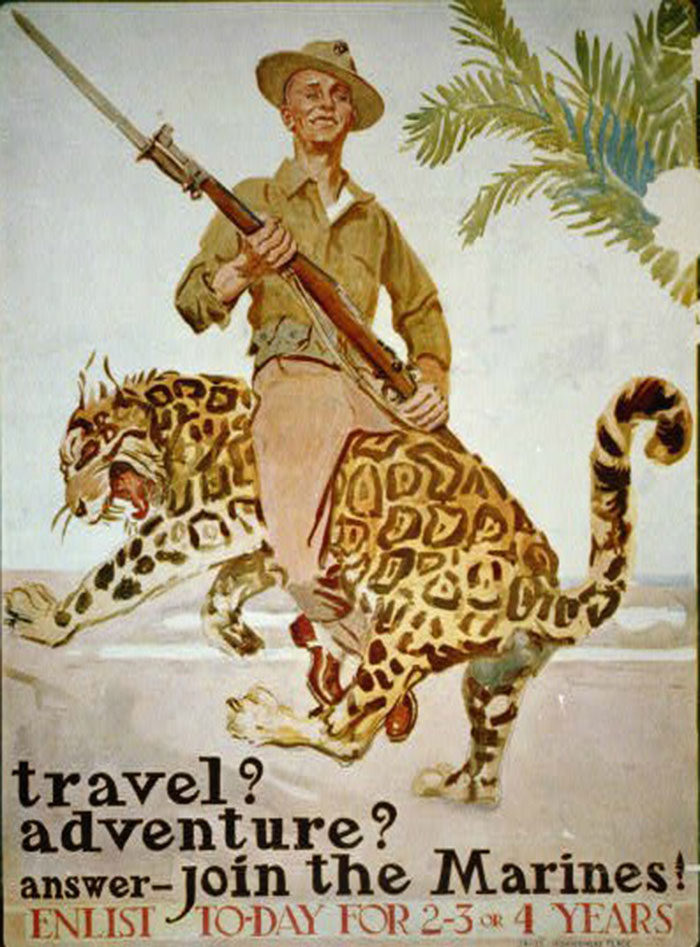
The Army wasn’t the only military branch to promise the world to prospective soldiers. The Marines division did the very same, and produced some of the best posters to be released in 1917.
Here’s a James Montgomery Flagg poster that suggests soldiers will be able to see cheetahs. It is questionable how inspired they felt, as this was practically impossible during the wall.
Marines stand for bravery, and Sidney H. Riesenberg knew this when creating this poster. The marines were supposed to fight first, and so they did.
The Army
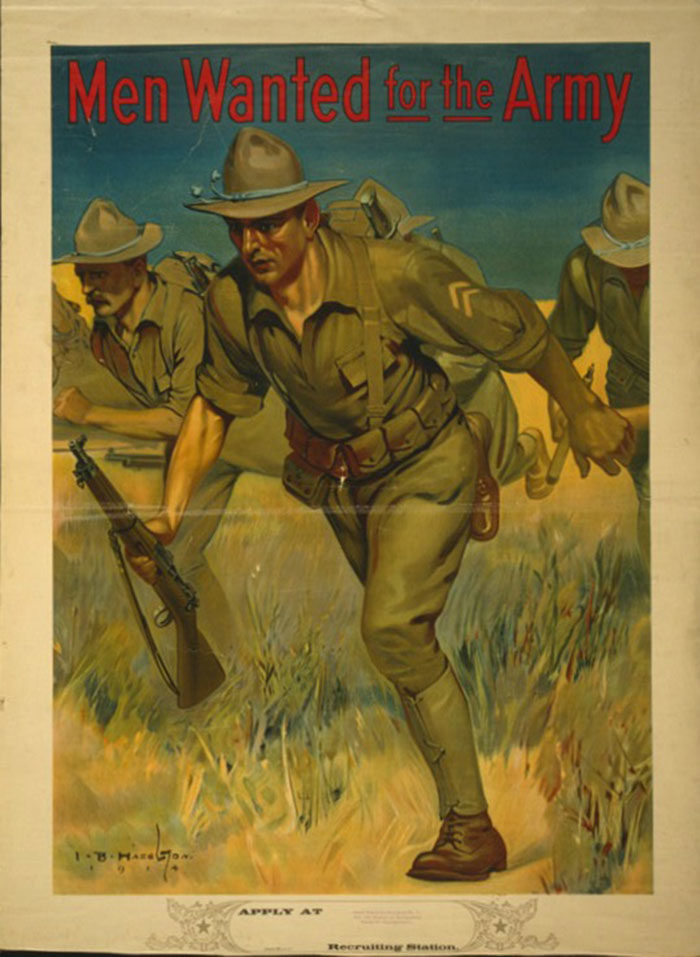
Our next poster is the work of I.B. Hazelton, and we admire its simplicity. It said nothing more than men being wanted for war, where they were asked with a friendly, non-imposing tone. Basically, Hazelton let art do the work.
This Tank Corps design is indeed unique, and signed by August William Hutaf. Yet, a question pops up as soon as you see it – does the cat symbolize the roughness of the Corps, or is it afraid from them?
The same as Canada, the U.S. hoped to bring merchants and artists on board, and the process wasn’t easy. This is why they came up with a whole new approach – promising training for anyone interested in these skills, and a secured job once they come back home.
Among other things, WW1 was the first conflict to employ planes. The division in charge was US’s Air Service (the original name of today’s Air Force). Charles Livingston Bull created some amazing posters inviting people to be pilots, but also to become part of the aviation industry.
We can say with all certainty that he played a major role in the recruitment process, as everyone know how dangerous these positions were.
Britons. Join Your Country’s Army!
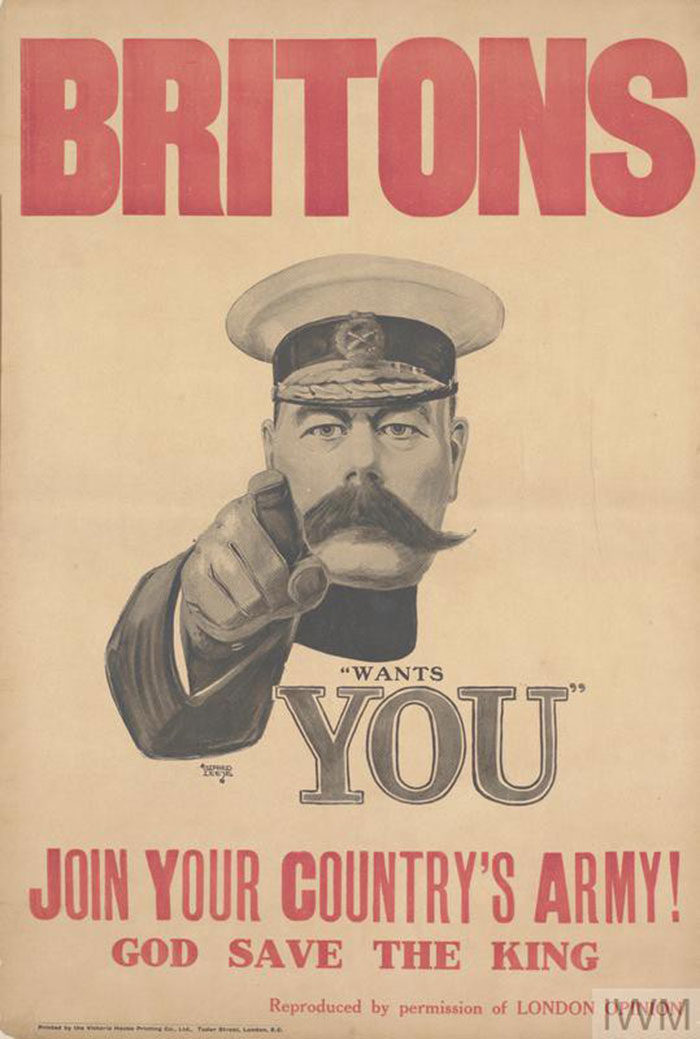
Here comes no other than the most popular WW1 poster, despite of the fact that you can only see Marshal Lord Kitchener asking recruits to join the army. Ever since its first appearance in 1914, this poster improved its iconic status, and is very well known all around the world.
Many countries created their own version of this poster, including the US where Kitchener’s image was replaced with Uncle Sam.
Women of Britain say ‘Go!’
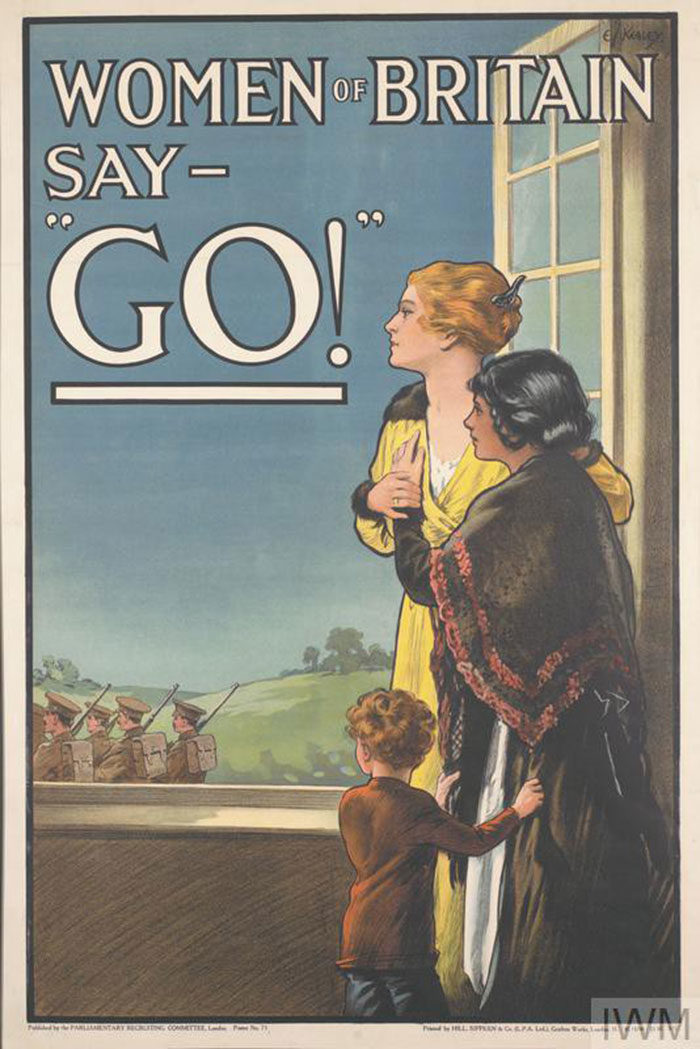
We present you the highlight of WW1’s commercial advertising technique – a powerful, women-oriented recruitment poster that asks the female population to help the military. This great WW1 poster was supposed to inspire women to motivate their men to join war, and it did it very cleverly – by guaranteeing them and their children protection.
The posters didn’t really accomplish their mission – so it seems that women preferred posters that ask them to engage in paid work.
WOMEN URGENTLY WANTED FOR THE W.A.A.C.
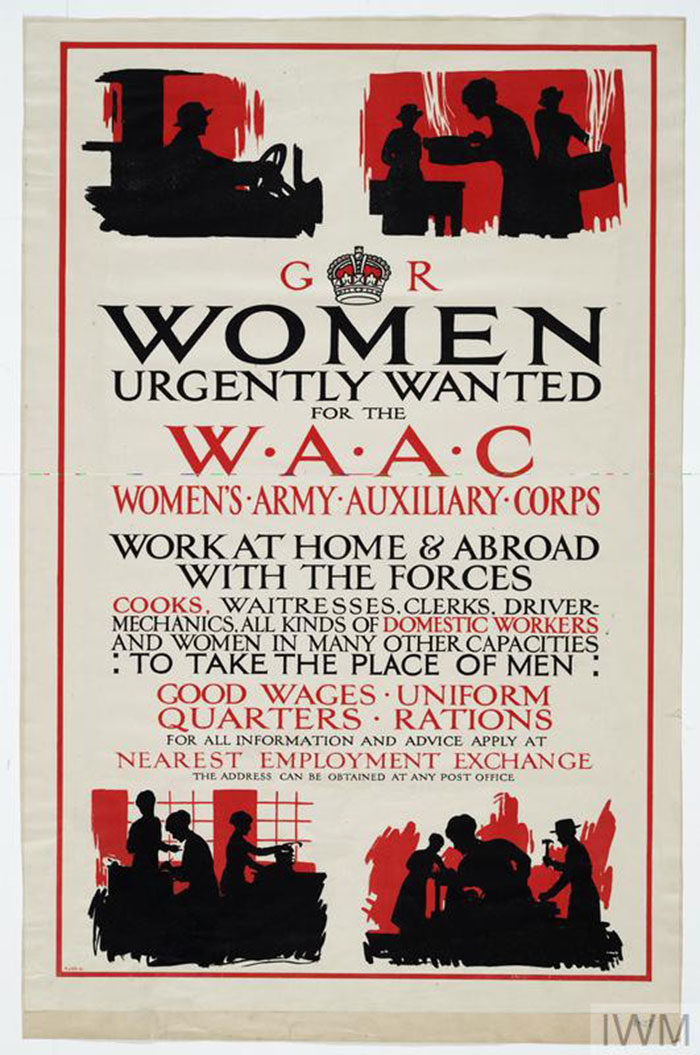
In December 1916, the US Army established a Women’s Auxiliary Corps (WAAC). The role of its members was to carry out different non-combatant tasks in France, so that men would be free to go to the front and fight. By the end of 1917 the unit had a total of 9,000 members. This recruiting poster is devoted to it.
Are You in This?
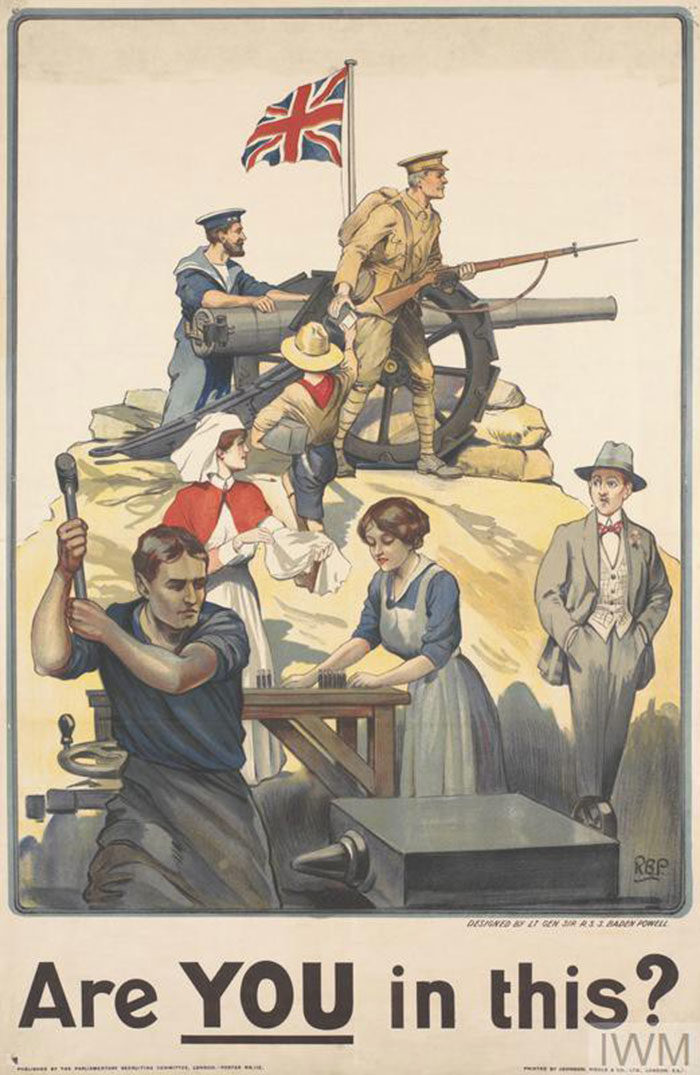
Robert Baden Powell had two great achievements in his life: Establishing the Scouting movement, and creating this amazing piece of art. He showed different society groups new ways to contribute to the war, and he pointed scouting as one of them.
On the poster, we can see a man smoking a cigarette and holding his hands in the pockets, so that the people not yet involved can identify with him. If you’re looking for posters with iconic war slogans, you should definitely get this one!
Step Into Your Place
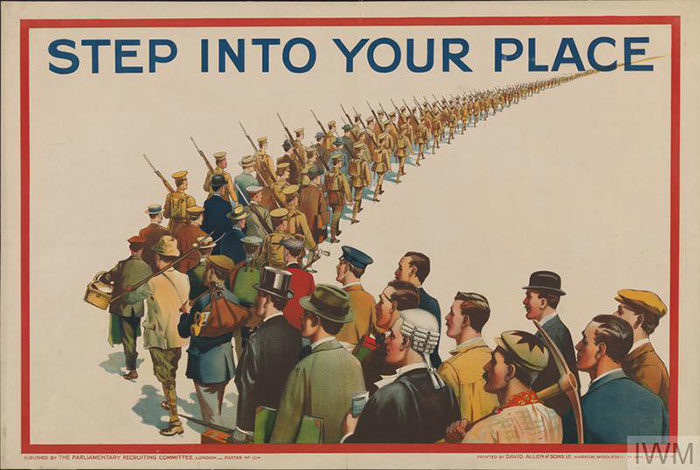
What this poster displays is united Britain, where all society groups unite their efforts to win the war. All of them carry their own tools and skills, which is a clear message that everyone can contribute.
Sportsmen’s One-thousand
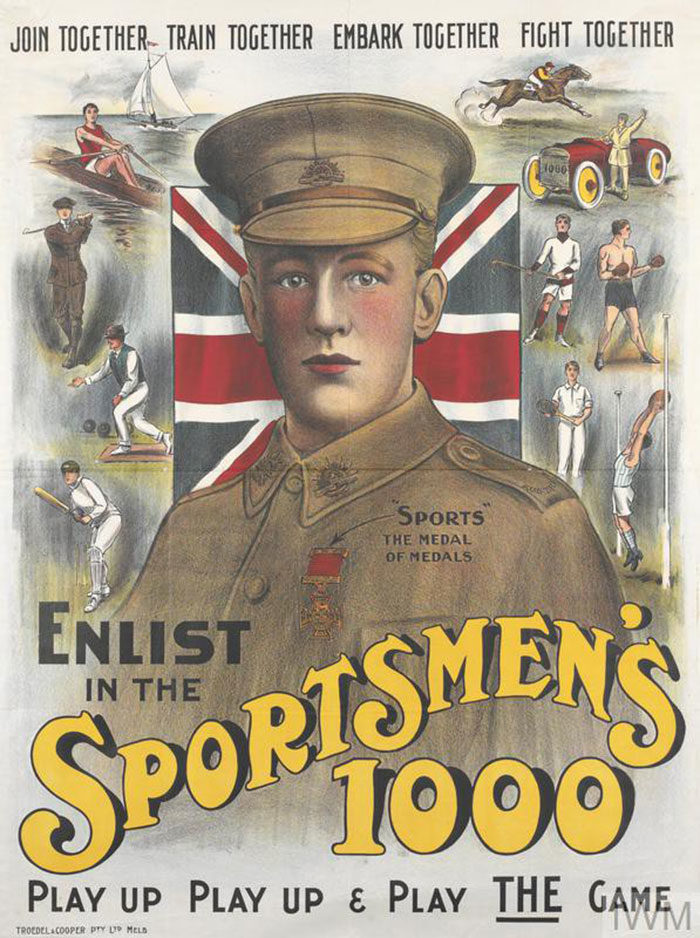
British poster artists didn’t take long to establish a connection between sports and war preparation. They used the patriotism and team spirit of sportsmen as tools of motivation, making sure that all citizens can identify with it.
This Soldier is Defending India
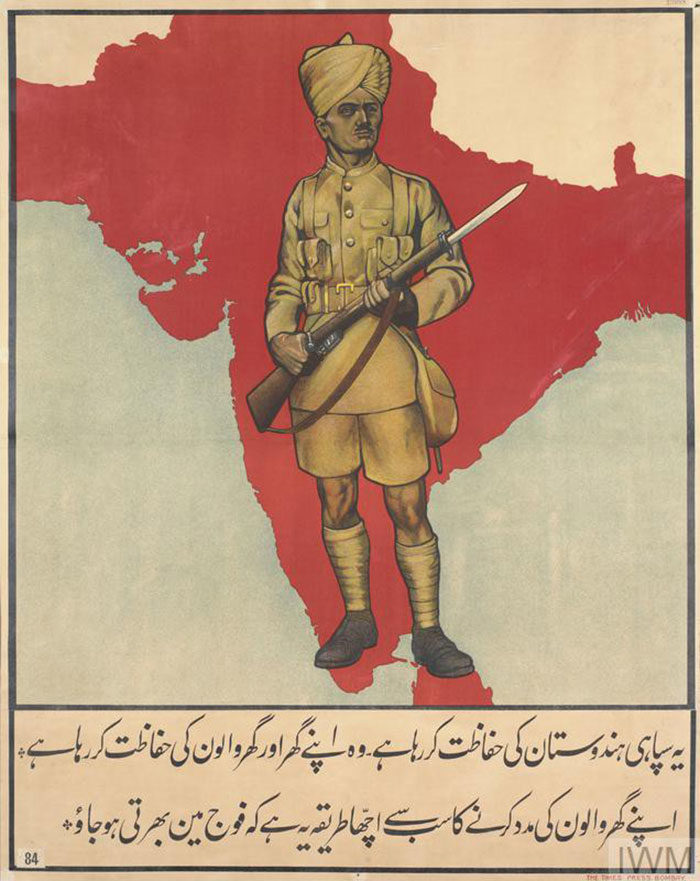
Recruitment in India was also not left out of the picture. As you can see on this particular poster, there is even a blank strip on the bottom for the message to be translated for each specific region. This made the posters more flexible and adaptable to their audience, which was important in India’s rural and uninformed society.
? [The Question Mark]
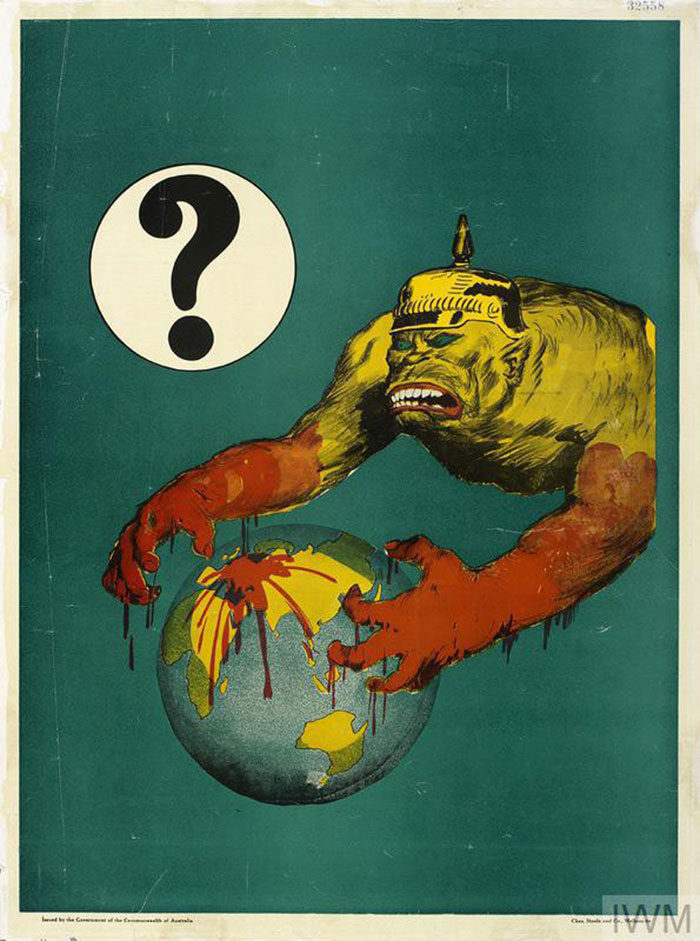
This WW1 recruitment poster belongs to Australia’s last WW1 Recruiting campaign, and represents another classic in the world of poster art. It shows us a monster with a German helmet (symbolizing German nationalism and militarism), but yet counts as one of the most sophisticated pieces in all war campaigns of the time. What we can certainly tell looking at it is that it has a different graphic imagery than the one used on British posters.
New Germany
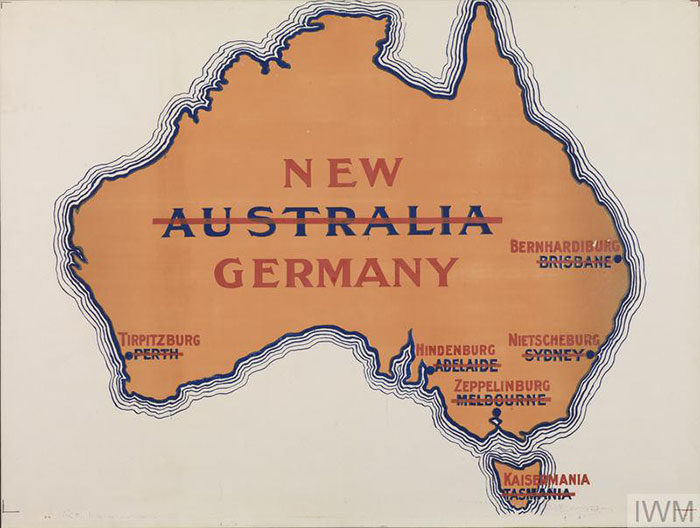
A poster we didn’t think existed – here’s an image of Australia freshly occupied by Germany! It is true – Australians never really feared such developments, but they still didn’t want Germany to rule the world. Nonetheless, this became one of the most popular WW1 recruiting poster.
Irishmen Avenge the Lusitania
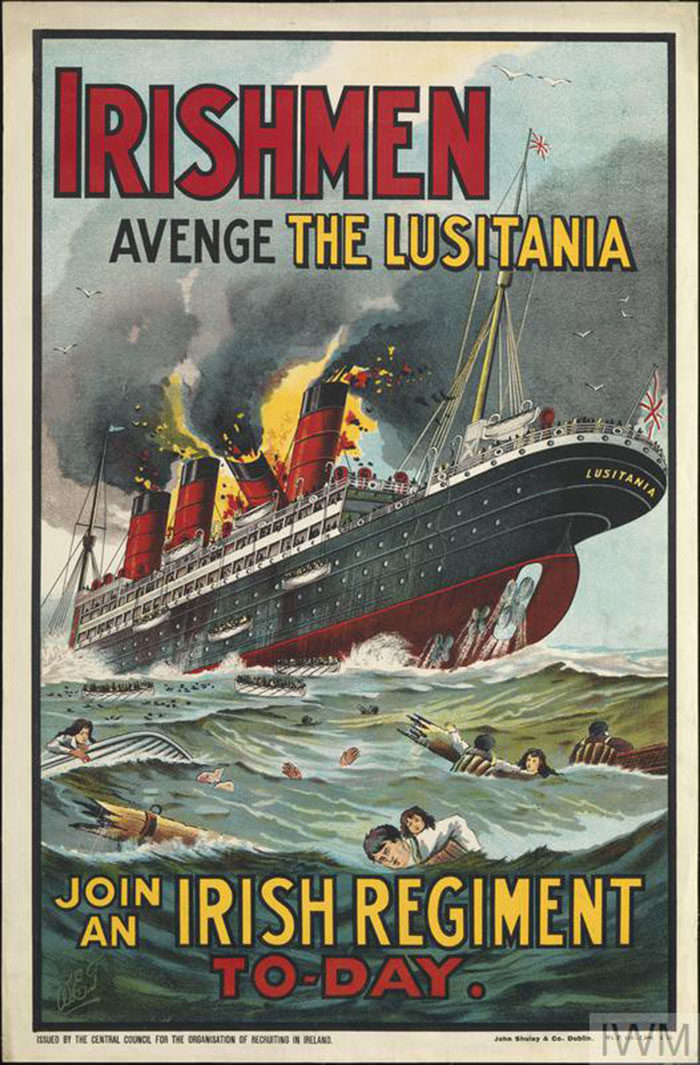
In May 1915, German U-Boat sunk Ireland’s RMS Lusitania passenger liner. The attack cost more than 1000 passengers their lives, and it thus gained the reputation of a very controversial act of war. This enlistment posters masterwork invokes the very same incident to motivate people to fight, and its core value is revenge.
Remember Scarborough
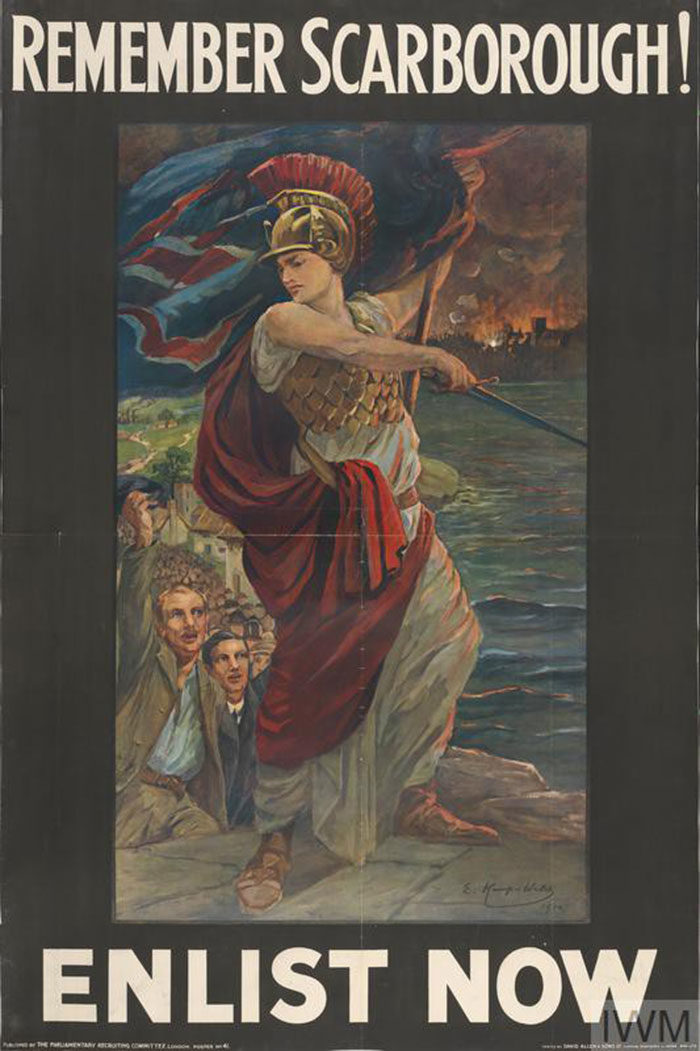
Here’s another recruitment poster looking to incent avenging feelings. It displays Germany’s 1914 High Seas Fleet Scouting Grouped bombing on North Sea ports Scarborough, Whitby, Hartlepool and West Hartlepool. The death toll of these attacks was 137 victims, while 592 people were wounded.
Revenge and courage for people to join the military were not the only milestones this poster tried to achieve – it was also an angry message directed towards the British public and the Royal Navy which failed to protect these towns.
For the Glory of Ireland
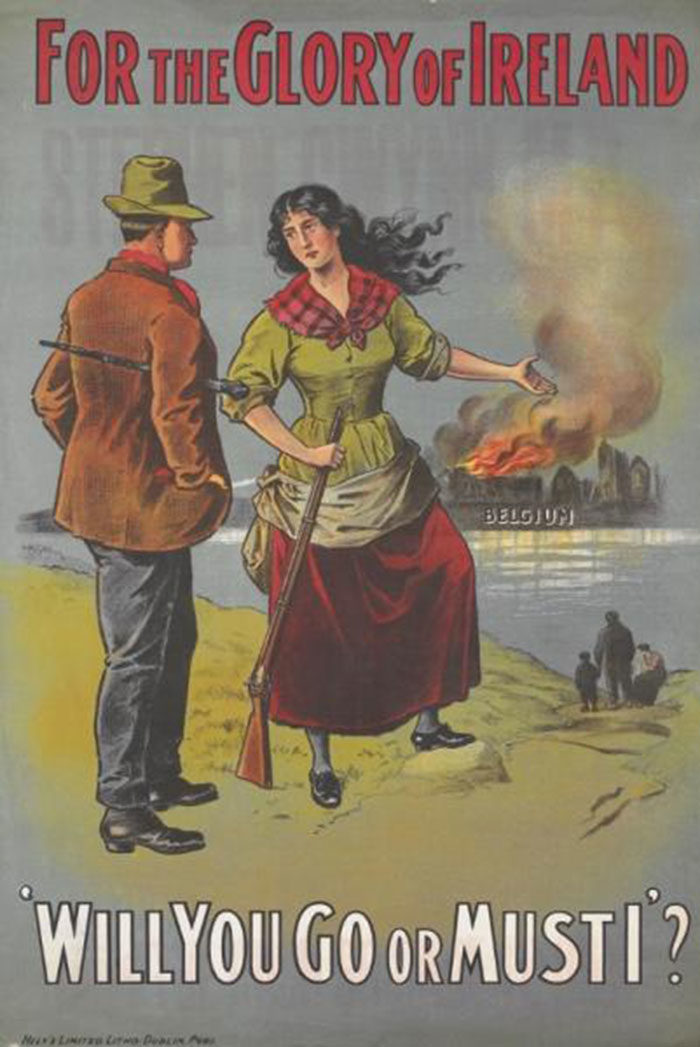
Ireland is the mother land of many great recruitment posters, including this one. The artist’s main intention was to use Germany’s invasion of Belgium to motivate people to fight, in particular religious citizens who’d defend this fellow Catholic country.
Who Can Beat this Plucky Four?
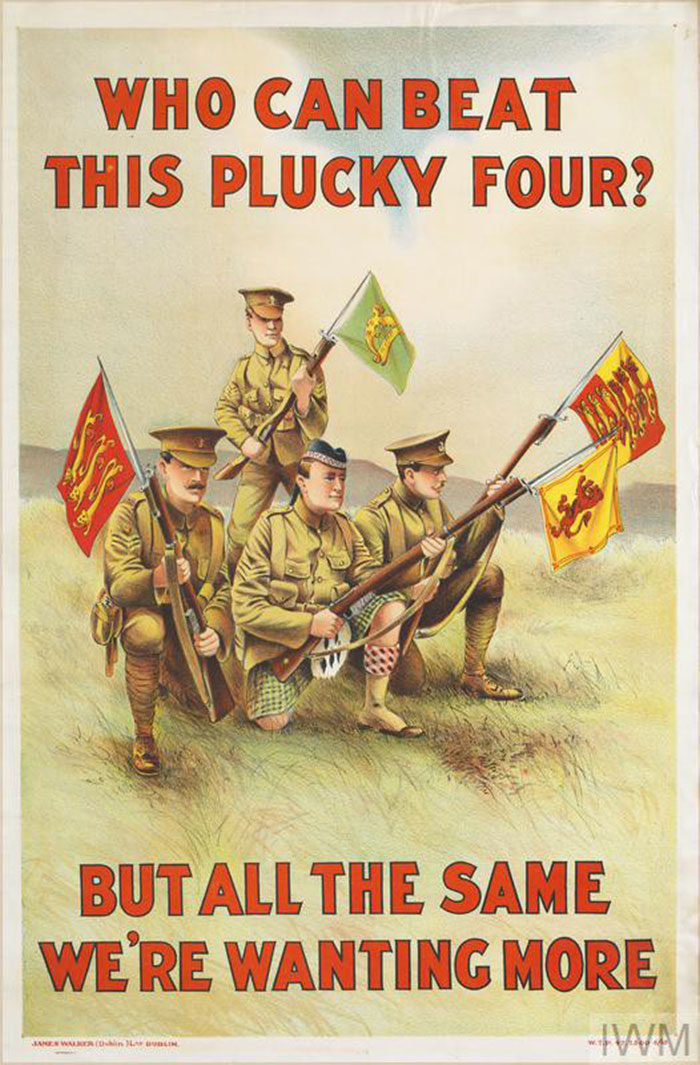
This is perhaps the most memorable WW1 poster from Ireland – English, Scottish, and Welsh troops getting ready for war, and a lonely Irish soldier standing behind them.
Created in 1915, the drawing intended to persuade Irish people from pursuing independence, and to encourage them to go to war instead. The main target group was, as expected, the Protestant community in the country.
FORWARD!

What makes this 1915 poster specific is the use of an actual image to recruit soldiers, as well as the iconic WW1 slogan. At that point, not that many people wanted to enlist for war, and conscription was the logical next step. Yet, posters like these continued encouraging people to assume their war duties before becoming conscripts.
The Military Service Act
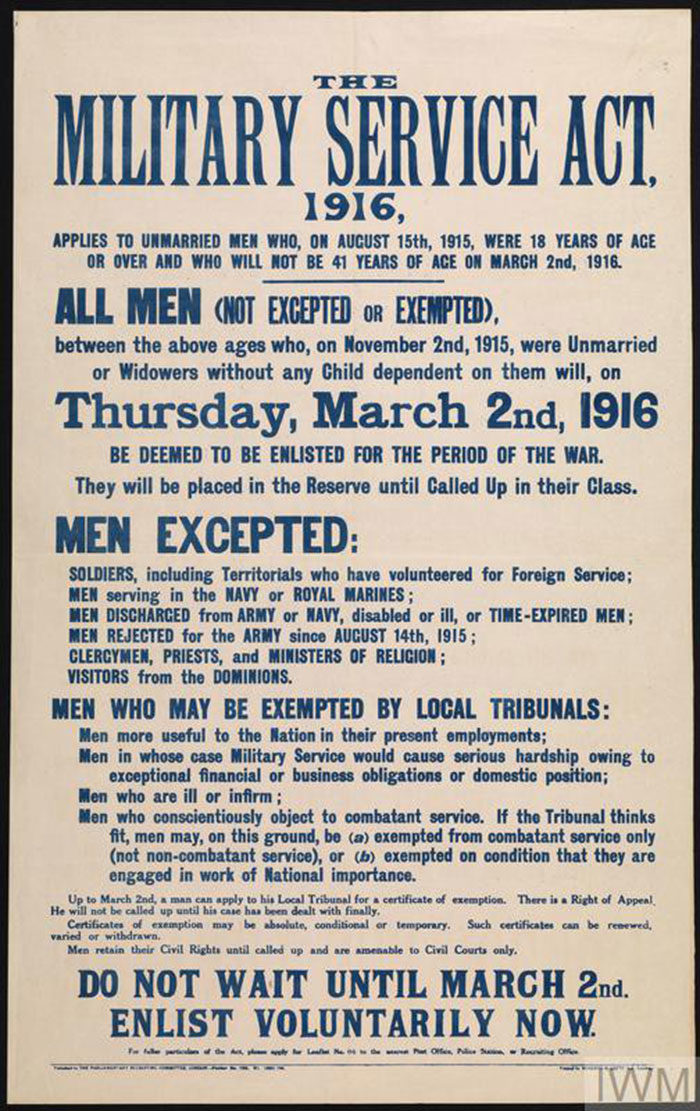
For those not familiar with it, Britain’s Military Service Act announced and introduced conscription during 1916. This particular poster aimed to inform people about the new legislation, but also to encourage them to go to war before it was official. Once the act came into force, artists created more posters with informative character than such persuading people to enlist.
Your King and Country Need You!
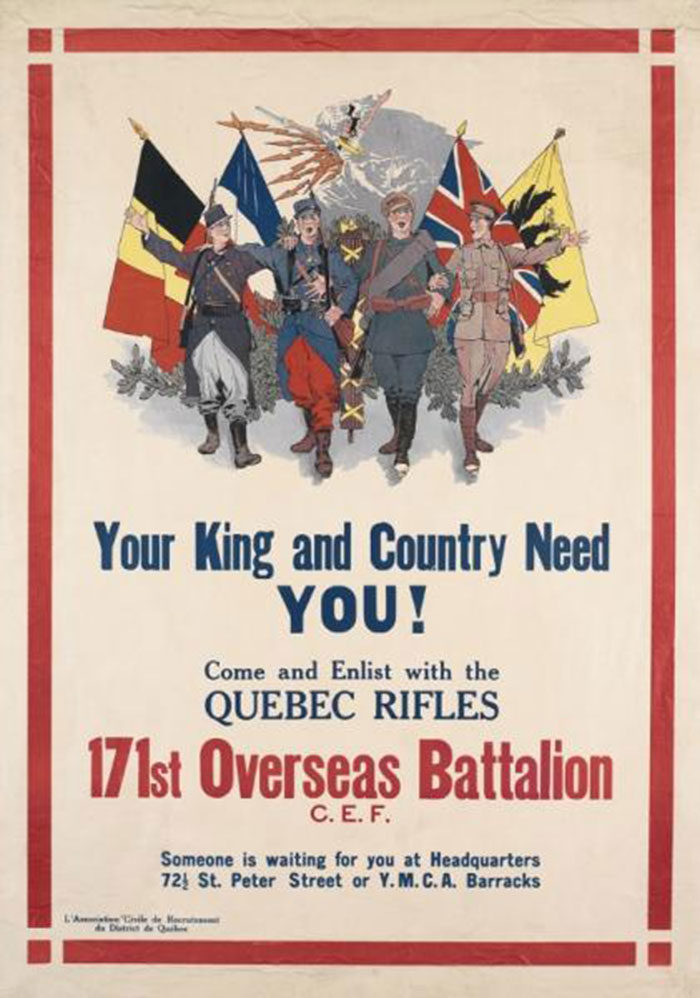
The Canadian Expeditionary Force used this join the army poster to motivate soldiers to join its Quebec Rifles unit. Despite of Canada not being a direct ally of Britain, Belgium, Russia, and France, it demanded its people to show some international solidarity, and to support the universal cause and values.
THE GREAT GAME
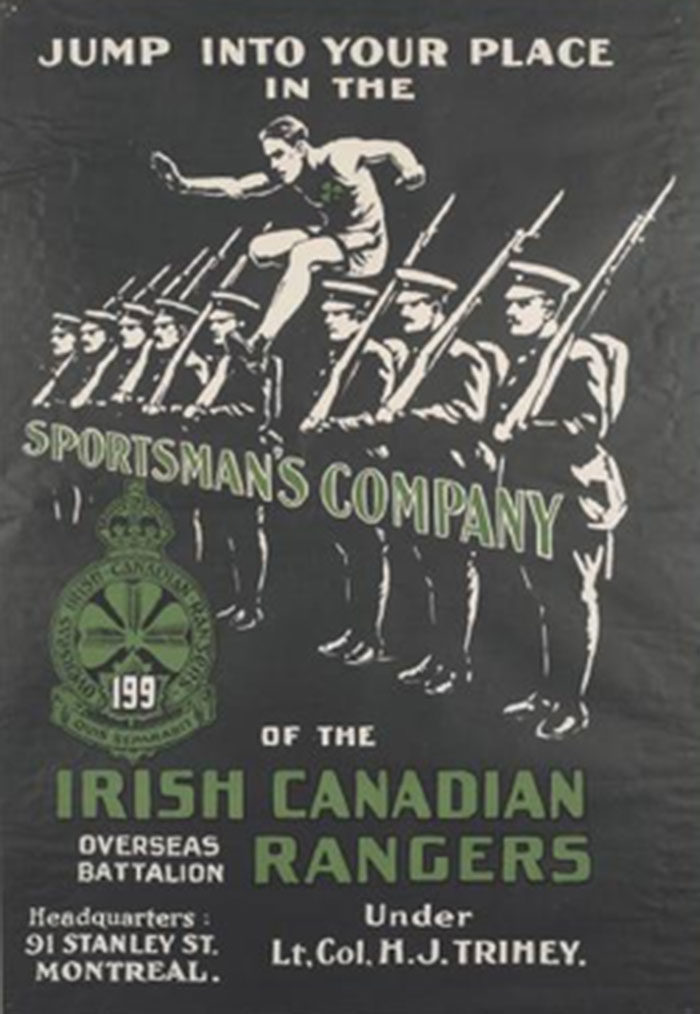
Sports imagery was a common and very efficient mean to encourage soldiers into battle, as revealed by this 1915 poster. We can see a scene from the Battle of Loos, where Irish Rifles threw a soccer ball into nobody’s land, and dribbled it while enemies shoot fiercely against them. They may have disobeyed the orders of their commanders, but they sent an important, slightly misleading message to their people: war is like a game, and skilled athletes belong on the front.
THE GOOD COMRADE
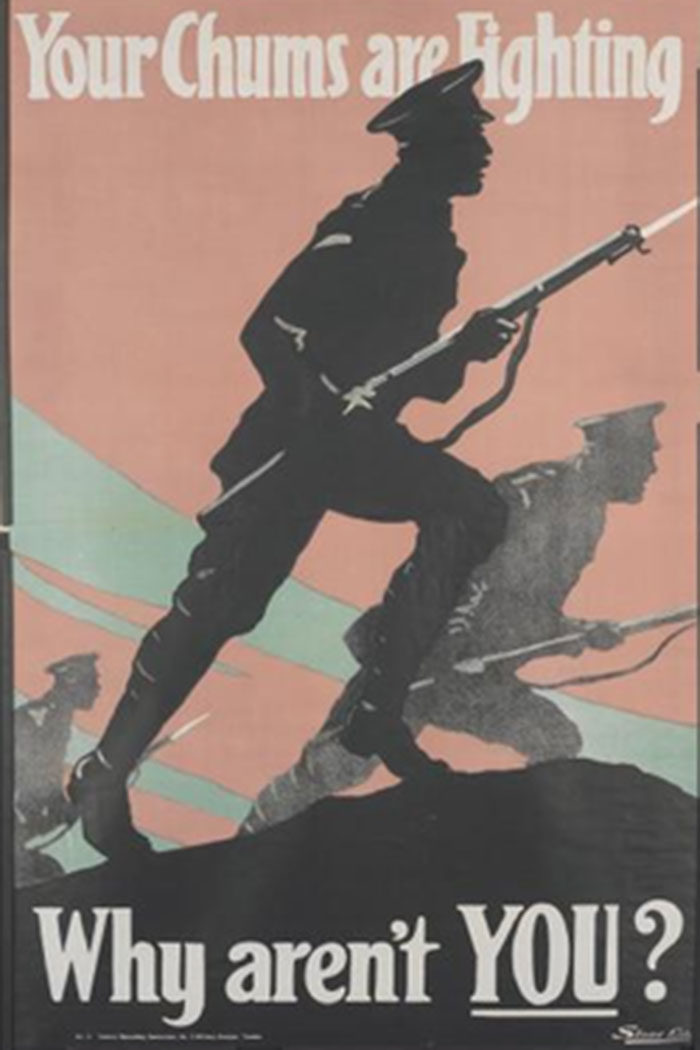
1809 was the year when German poet Ludwig Uhland published his masterpiece Ich hatt’ einen Kameraden (I used to have a comrade). It is a romanticized poem over a wartime friendship where the poet mourns for his lost comrade, soon to be translated in many languages worldwide.
It doesn’t matter on which side of the line you stand – you will always regret losing a friend who perhaps helped you survive. It is a whole tradition and core of the military culture, and Uhland only brought it to daylight in a sad and descriptive way. His main contribution was perhaps the phrase ‘I had a comrade’ which we can see on many posters and artworks worldwide.
Ending thoughts on these WW1 posters
We’ve selected and displayed some of the most popular WW1 posters we believe deserve your attention. Alongside their artistic value, they also convey meaningful messages, and often do so with smart metaphors and allegory. For what is worth, they’re decent representatives of the time when they were created!
If you enjoyed reading this article about the WW1 posters, you should read these as well:
- How To Make Great Poster Designs (156 Examples)
- 39 Free poster mockup examples to download in PSD format
- World Map Poster Examples For Passionate Travelers
- Typography posters: Tips, Best Practices, And 108 Examples
- The Best Star Wars Posters: Originals and fan-made ones
The post WW1 Posters: Recruitment and propaganda posters from the first world war appeared first on Design your way.
Source: https://ift.tt/2DZvMJ3

No comments:
Post a Comment